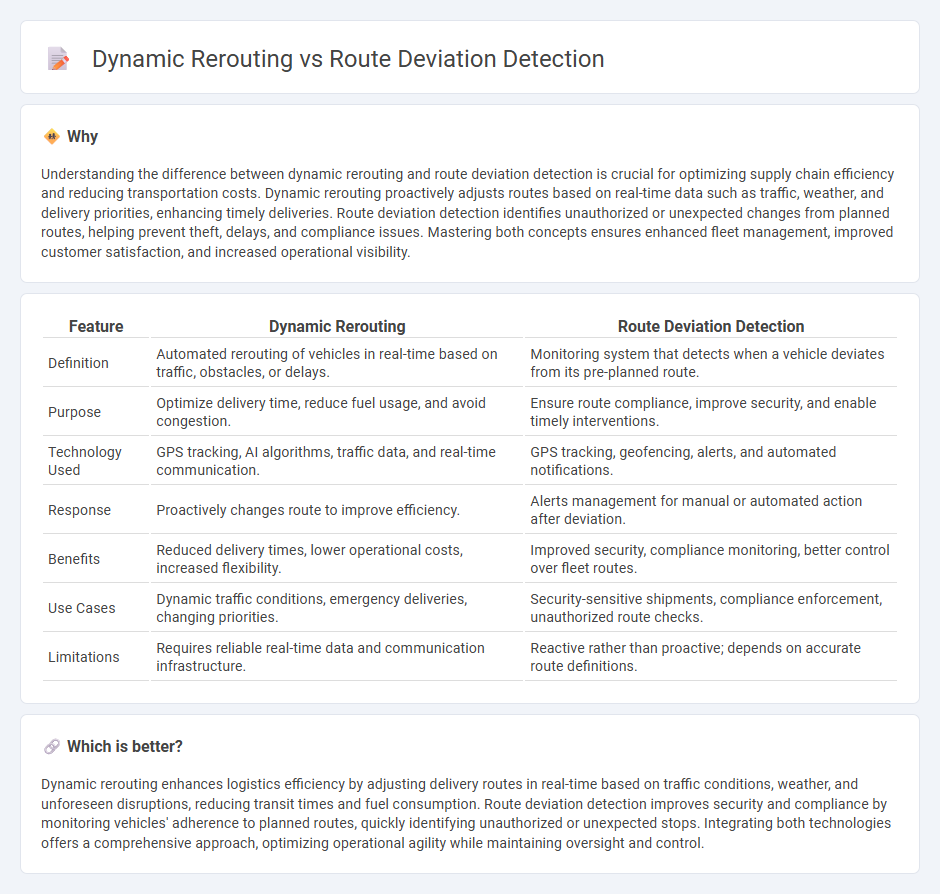
Dynamic rerouting utilizes real-time data and advanced algorithms to adjust delivery paths promptly, increasing efficiency and reducing transit times. Route deviation detection monitors vehicle movements against planned routes to identify unauthorized or unexpected detours, enhancing security and compliance in logistics operations. Explore how integrating these technologies can transform supply chain management and improve operational accuracy.
Why it is important
Understanding the difference between dynamic rerouting and route deviation detection is crucial for optimizing supply chain efficiency and reducing transportation costs. Dynamic rerouting proactively adjusts routes based on real-time data such as traffic, weather, and delivery priorities, enhancing timely deliveries. Route deviation detection identifies unauthorized or unexpected changes from planned routes, helping prevent theft, delays, and compliance issues. Mastering both concepts ensures enhanced fleet management, improved customer satisfaction, and increased operational visibility.
Comparison Table
| Feature | Dynamic Rerouting | Route Deviation Detection |
|---|---|---|
| Definition | Automated rerouting of vehicles in real-time based on traffic, obstacles, or delays. | Monitoring system that detects when a vehicle deviates from its pre-planned route. |
| Purpose | Optimize delivery time, reduce fuel usage, and avoid congestion. | Ensure route compliance, improve security, and enable timely interventions. |
| Technology Used | GPS tracking, AI algorithms, traffic data, and real-time communication. | GPS tracking, geofencing, alerts, and automated notifications. |
| Response | Proactively changes route to improve efficiency. | Alerts management for manual or automated action after deviation. |
| Benefits | Reduced delivery times, lower operational costs, increased flexibility. | Improved security, compliance monitoring, better control over fleet routes. |
| Use Cases | Dynamic traffic conditions, emergency deliveries, changing priorities. | Security-sensitive shipments, compliance enforcement, unauthorized route checks. |
| Limitations | Requires reliable real-time data and communication infrastructure. | Reactive rather than proactive; depends on accurate route definitions. |
Which is better?
Dynamic rerouting enhances logistics efficiency by adjusting delivery routes in real-time based on traffic conditions, weather, and unforeseen disruptions, reducing transit times and fuel consumption. Route deviation detection improves security and compliance by monitoring vehicles' adherence to planned routes, quickly identifying unauthorized or unexpected stops. Integrating both technologies offers a comprehensive approach, optimizing operational agility while maintaining oversight and control.
Connection
Dynamic rerouting in logistics relies on real-time data to adjust delivery paths efficiently, while route deviation detection monitors any unplanned changes from the predefined route. Together, these technologies enhance supply chain visibility, reduce delays, and optimize transportation costs by enabling rapid responses to traffic conditions, weather disruptions, or operational issues. Their integration ensures that logistical operations maintain accuracy and reliability, improving overall delivery performance.
Key Terms
**Route Deviation Detection:**
Route deviation detection utilizes GPS tracking and geofencing technologies to identify when a vehicle strays from its predefined path, enhancing fleet security and operational efficiency. This method allows real-time alerts to fleet managers, enabling swift interventions to prevent disruptions or unauthorized detours. Discover how route deviation detection can transform your logistics and improve route compliance by exploring advanced fleet management solutions.
Geofencing
Route deviation detection leverages geofencing technology to monitor when vehicles or assets move outside predefined geographic boundaries, enabling immediate alerts to prevent unauthorized detours or potential theft. Dynamic rerouting uses geofencing data to adapt routes in real-time, optimizing travel based on traffic conditions, road closures, or unexpected obstacles, thereby improving delivery efficiency and reducing operational costs. Discover how integrating geofencing enhances transportation management by exploring advanced route deviation detection and dynamic rerouting solutions.
Real-time Tracking
Route deviation detection uses GPS data to identify when a vehicle strays from its planned path, enabling immediate alerts for potential delays or security issues. Dynamic rerouting integrates real-time traffic information and vehicle tracking to automatically adjust routes for optimal efficiency and reduced travel time. Explore how real-time tracking enhances both technologies for smarter fleet management solutions.
Source and External Links
Deviation from the route - Documentation - Navixy - The route deviation detection feature monitors adherence to predefined routes by creating route geofences and notifying users whenever a vehicle or object deviates from these specified routes to enhance operational efficiency and security.
Route Deviation Monitoring - United Tracker - Route deviation monitoring systems automatically track vehicles in real-time, send instant deviation alerts, analyze deviation incidents with detailed reporting, and provide fleet-wide insights to ensure route compliance and optimize fleet operations.
Route Deviation System | Real-time Deviation Alerts - This system offers real-time tracking and immediate alerts when a vehicle deviates from its assigned route, allowing fleet managers to respond quickly and analyze deviations including alternative routes taken, timing, and sequence adherence for comprehensive route compliance management.
 dowidth.com
dowidth.com